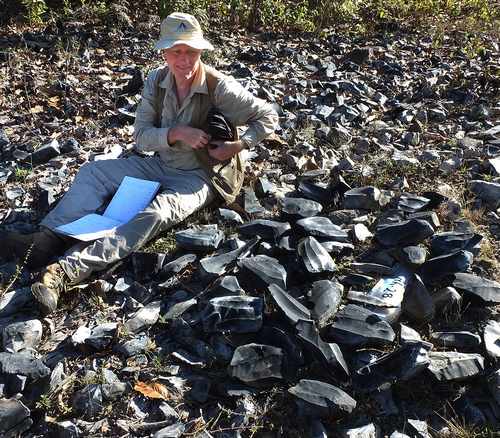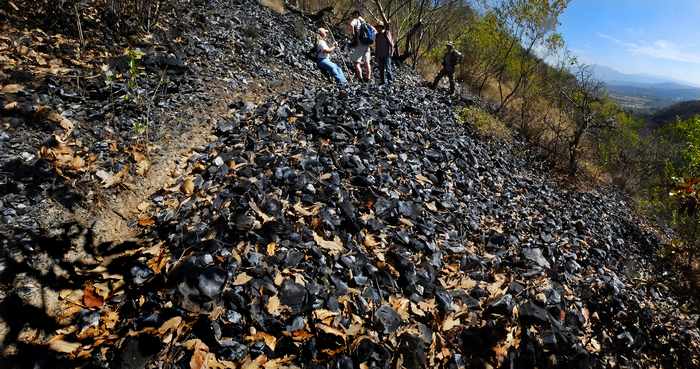|
By John Pint
 In 2013 I paid my first visit to Selva Negra, the popular name for the Ahuisculco "Selva Negra" Flora
and Fauna Sanctuary, located 30 kilometers southwest of
Guadalajara, Mexico's second-largest city. This is a biological
corridor that was selected to help link Bosque la Primavera and the
Sierra de Quila by preserving the Sierra de Ahuisculco. Selva Negra is
actually the title of a song by Guadalajara rock group Maná which
finances the restoration and conservation of the corridor in
cooperation with the local ejido de Ahuisculco.
In 2013 I paid my first visit to Selva Negra, the popular name for the Ahuisculco "Selva Negra" Flora
and Fauna Sanctuary, located 30 kilometers southwest of
Guadalajara, Mexico's second-largest city. This is a biological
corridor that was selected to help link Bosque la Primavera and the
Sierra de Quila by preserving the Sierra de Ahuisculco. Selva Negra is
actually the title of a song by Guadalajara rock group Maná which
finances the restoration and conservation of the corridor in
cooperation with the local ejido de Ahuisculco.
I was introduced to this bosque by Franky Alvarez, who summed it up as
“two big cerros, one composed of black obsidian and the other of red.”
Indeed, anyone who takes a stroll along the paths of Selva Negra can't
help be impressed by the huge quantities of obsidian underfoot,
obsidian of great purity and quality.
But something else impressed me on that first visit three years ago. We
had parked our car in a quarry before entering the park on foot. It
looked like they were mining jal, which consists of pumice and other
solids ejected during a volcanic explosion, but a close examination of
the quarry wall revealed something I had never seen before. In the wall
there were literally hundreds of hard, round balls, obviously not
chunks of pumice, hosted in black obsidian. What were they?
That's the question I asked Canadian geologist Chris Lloyd and it
triggered his own geological study of the Ahuisculco area, a study
which is still ongoing today.

As for the naturally formed stone balls, Lloyd learned that they were
spherulites, formed by crystalization of the molten obsidian and
frequently associated with deposits of obsidian. Occasionally these
round formations can grow to enormous sizes, in which case they are
called megaspherulites, an example being the Great
Stone Balls or Piedras Bola of Ahualulco, which sometimes
reach a diameter of three meters.
In February of 2015, archaeologist and obsidian
specialist Dr. Rodrigo Esparza visited the quarry and
surrounding obsidian deposits. He discovered that the area was dotted
with the remains of ancient obsidian mines and workshops and pointed
out to Lloyd that no geological study of these or any of Jalisco's
other obsidian deposits (which are reportedly the fourth largest in the
world) had ever been undertaken.
All of this piqued Lloyd's curiosity and for the last year he has been
engaged in figuring out the mechanisms which produced the Ahuisculco
flows and in mapping their extent.
“So far I've mapped 14 square kilometers,” he told me, “and I've found
69 individual flows spread over an area of 359 hectares.”
With the help of several “sherpas” Lloyd collected around 200 samples
and delivered them to Esparza for Trace Geochemistry Analysis, which
produces an extremely detailed list of all the elements present in a
piece of obsidian. “We need this data,” says Lloyd, “to determine which
flows connect together and which are separate flows.”
Lloyd has found that most of the obsidian in the Ahuisculco flows is
pure black or black streaked with gray, with occasional intrusions of
“Indian Blood” obsidian which is a mixture of red and black. “I also
discovered that there have been some notable eruptive phases in the
area. So It's similar to the Primavera Caldera in that sense. The
obsidian was not just flowing on the surface, but there was at least
one big bang, which left pyroclastic tuff deposits at least two or
three meters deep.”
Detailed mapping of obsidian deposits has been carried out in very few
places around the world. “In Mexico, there have been a few geologic
studies of the Sierra de Pachuca—the most famous obsidian in
Mesoamerica,” says Lloyd. the only problem there, is that most of the
actual obsidian is buried 20 to 40 meters under an avalanche deposit,
so there's not much detail as to the original obsidian flow.” As for
Jalisco, nothing of the sort has ever been attempted and the size of
the Ahuisculco flow was unsuspected. “It could turn out to be the
biggest flow in Mexico,” he added.
“When will you finish your survey?” I asked the geologist.
“Well,” he replied, “the whole sierra has 100 square kilometers and
I've finished 14 of them—and that's taken me a year. So, unless I step
up my visits—I've been going there once a week—I'm looking at another
three years, at least.”
In the course of his explorations, Chris Lloyd has located over 300
obsidian mines and workshops in the Ahuisculco woods. A typical mine
may often appear as a low depression, typically surrounded by thousands
of “rejects” among which one might find broken or incomplete knives and
spearheads. If you would like to visit Selva Negra, check chapter five
of Outdoors in Western
Mexico Volume two or see Ahuisculco
to Selva Negra Woods on Wikiloc.
|

